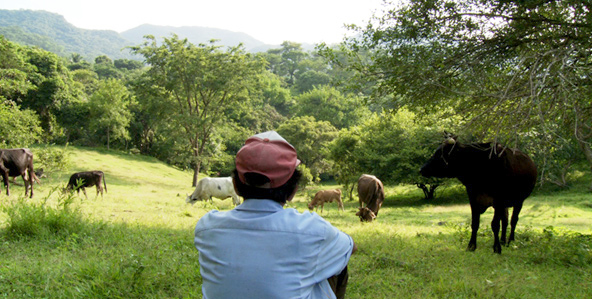|
Reviews of Recent Independent, Foreign, & Documentary Films in Theaters and DVD/Home Video

THE TINIEST PLACE What does peace look and sound like after a brutal civil war? Since peace was negotiated in 1992, the residents of the small town of Cinquera in the mountains of El Salvador, three hours from the capital, have reconstructed their town that was destroyed during a dozen years of conflict. Along the few streets, girls walk to school, boys play soccer, shepherds lead cattle, and women industriously sweep back the encroaching forest. But over the quiet scenes of daily life, the voices of seven residents describe the nightmares and insomnia they have to overcome to get through each day. And then there are the ghosts. In her grandmother’s home village, debut director Tatiana Huezo focuses first, and last, on the faces of interviewees who were parents and children during the civil war. Their voices were recorded separately from the beautiful images, but their words are woven together to present an overall portrait of one community. At first, their memories reflect the anguish of civilians caught between the violence of left-wing guerrillas and the right-wing military in a war where 80,000 are dead or missing. But as the camera catches the initials FMLN (for the Farabundo Martí National Liberation Front) scrawled in red on a shop, their overwhelming grief for the forever youthful ghosts they talk to is mixed with pride for their loved ones’ courage. One man (none of the speakers is identified on screen) describes his love of books and remembers how his life—and the village—was changed when a new priest came to preach liberation theology, and they all began questioning the government and its support for the rich over the poor. As cinematographer Ernesto Pardo’s 35 mm camera—unusual for documentaries—continues to view pastoral scenes of lovely sunrises and sunsets over the forest, the voices explain how their town became a specific target for annihilation, and detail the atrocities perpetuated against them. Past and present, the living and the ghosts, eerily collide when one man leads the filmmakers way up the mountain to the cave where several families (with 18 children) tried to hide together from the cruelties of the persistently searching soldiers—he spent two years inside and hadn’t faced returning before. In the pitch black, the fear and threat of imminent death are still palpable. The voices proudly describe how even the youngest children helped the insurgent movement as messengers after resentment mounted against the horrors of the military’s oppression. Parents weep in describing how dedicated their teenage children were to give their lives to the cause (and when they recount how their children’s spirits enter their dreams). Then for the first time, the film provides a look at the faces of the dead in a montage with their names and at a church’s memorial wall of photographs of the slain, who remain young forever—these are the only documentation of the past seen in the film.
The interviews and images are so intimate it’s surprising that there were several crew members. Though the lack of identification of the voices and the faces
is a bit confusing and frustrating to keep track of individuals and family relationships, The Tiniest Place is a universal and specific story of solidarity—the shared memories give this community the courage to keep on living victoriously over inhumanity. After showing at festivals, the documentary was screened during
the International Documentary Association’s annual New York and Los Angeles DocuWeeks showcases to qualify
for Academy Award consideration.
Nora Lee Mandel
|

